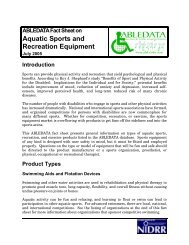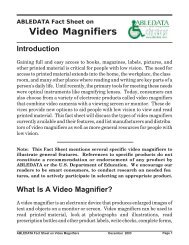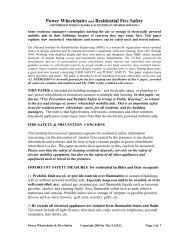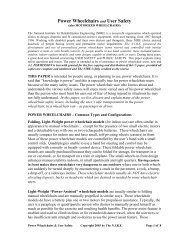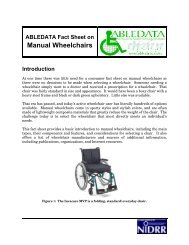Vision Aids for Impaired Peripheral Vision or Tunnel Vision - AbleData
Vision Aids for Impaired Peripheral Vision or Tunnel Vision - AbleData
Vision Aids for Impaired Peripheral Vision or Tunnel Vision - AbleData
Create successful ePaper yourself
Turn your PDF publications into a flip-book with our unique Google optimized e-Paper software.
faceplates (as wide as 1/2 to 3/4 inch). The FX tubes were mounted high to allow direct<br />
vision, underneath, <strong>f<strong>or</strong></strong> seeing detail and judging distance. By slightly lowering the head<br />
and raising the eyes, the user sees through the FX devices with non-linear <strong>or</strong> liner views<br />
of 50 to 140 degrees – the exact width depending on the design of the FX device. A few<br />
patients chose to have installed on each carrier lens, an angled- out FX device (mounted<br />
as shown in Fig. 2) instead of using the parallel-mounted tubes. These users had<br />
binocular direct vision, but monocular side vision through one <strong>or</strong> the other angled-out<br />
FX devices.<br />
People with Unaided Visual Field Widths: 10 to 20 degrees -with REDUCED acuity<br />
Reduced visual acuity: Most patients in this categ<strong>or</strong>y – after trying both types of field<br />
expanders (Linear and Non-Linear) – chose the Linear type FX devices in <strong>or</strong>der to have<br />
the larger and sharper expanded visual fields. About half chose to have the tubular FX<br />
devices mounted low (left as shown in Fig. 3) on both lenses. The other half chose to<br />
have the Linear FX devices mounted high (right as shown on Fig. 3). The mountings<br />
were at the users’ PDs <strong>or</strong> pupillary distances, with exactly parallel mountings. The<br />
significant variables, from patient to patient, were faceplate focus adjustments and<br />
faceplate diameters. Those with 10 degree unaided visual field widths did best with<br />
narrower faceplates (as narrow as 1/4 to 1/2 inch). Thus with 20 degree unaided visual<br />
field widths did best with wider faceplates (as wide as 1/2 to 3/4 inch). The FX tubes<br />
mounted low allowed expanded-field vision, through them, <strong>f<strong>or</strong></strong> seeing the ground and<br />
their feet, clearly, while walking. The FX tubes mounted high required deliberate<br />
lowering of the head <strong>f<strong>or</strong></strong> use. The FX devices used were either 2x, 3x <strong>or</strong> 4x low-vision<br />
bioptic telescopes, reverse-mounted to act as linear image minifiers rather than as<br />
magnifiers. Depending on the devices used and the faceplate diameters and distances, the<br />
minified visual field width was usually in the range from 40 to 110 degrees. F<strong>or</strong> one-eyeat<br />
a-time use, the FX tubes could be angled toward each side, as in Fig. 2. However,<br />
most patients preferred parallel mountings at the PD to facilitate fused, binocular vision<br />
through the FX devices. This was found to be especially helpful when either <strong>or</strong> both eyes<br />
had scotomas (retinal dead spots) and/<strong>or</strong> reduced visual acuity.<br />
Night Blindness may result from the reduced peripheral vision, alone. Or, <strong>f<strong>or</strong></strong> a given<br />
person, there may be other, additional causes. An in<strong>f<strong>or</strong></strong>mative paper titled: “In<strong>f<strong>or</strong></strong>mation<br />
About <strong>Impaired</strong> Night <strong>Vision</strong> and Night Blindness” is available on request from this<br />
Institute and is a recommended reference. Electronic night viewing aids can sometimes<br />
be helpful. Some use visible light, <strong>f<strong>or</strong></strong> sh<strong>or</strong>t distances; others detect infrared <strong>f<strong>or</strong></strong> long<br />
distance night viewing.<br />
Safe Driving may be possible <strong>f<strong>or</strong></strong> some people having impaired <strong>or</strong> reduced peripheral<br />
vision, with unaided visual field widths greater than 75 degrees. Thusly disabled people<br />
may benefit from using field-expanding eyeglasses, wide-angle non-minifying rearview<br />
mirr<strong>or</strong>s in the vehicle, personalized on-the-road driver training, and residence in a state<br />
willing to road-test and license drivers with impaired peripheral vision. Even if able to<br />
drive safely and legally in daylight, some drivers will- and others will not- be able to<br />
drive at night. REAR-VIEW video systems, <strong>f<strong>or</strong></strong> safer driving, became available in<br />
2003. Some come with new cars and vans; others can be installed in existing vehicles.<br />
12 <strong>Tunnel</strong> <strong>Vision</strong> Copyright 2003 by The N.I.R.E. Page 12 of 13



